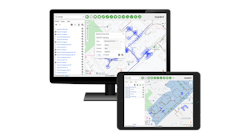The emergence of technologies like Network Functions Virtualization (NFV), Software Defined Network (SDN), and the Cloud, have signaled much promise for operators from the moment the industry started talking about them, with the Residential Gateway (RG) being just one area with the potential to benefit.
This potential has moved a step closer to reality with the release of the first ever specifications for the virtual RG, marking the conclusion of work on a landmark project and a significant step towards delivering the next-generation broadband networks of the future.
This diagram shows the traditional TR-069 and the approach using TR-317. Both implementations are anticipated to exist and be enhanced over a long period. Market-driven migration work is also being developed by the Broadband Forum.
Changing Landscape
The Broadband Forum’s Broadband 20/20 vision focuses on specific new home and business broadband opportunities that leverage SDN, the NFV distributed compute/network model, Internet of Things (IoT), and ultrafast technologies. Part of that is our latest set of specifications: Network Enhanced Residential Gateway (TR-317). These are a direct response to the shift the telecoms industry has undergone in recent years.
While the end-to-end architecture has remained fundamentally the same, the business ecosystem has changed significantly, with flagship value-added telco services becoming commoditized and over-the-top companies going from small startups to financial giants. At the same time the consumer electronics industry is flooding residential home networks with new devices. Alongside this, the IT ecosystem has changed and cloud services for residential customers have become commoditized as a result of virtualization and new generation technologies and network concepts such as NFV and SDN.
Enabling operator gateway services with the agility of Cloud-based software, and supporting some new use cases, is the purpose of the Network Enhanced Residential Gateway architecture.
Additional Revenue Streams
With this in mind, TR-317 provides requirements for an end-to-end architecture, creating a flexible and agile environment. TR-317’s virtual Customer Premises Equipment (CPE) eliminates the need to provision and attach new services directly to an end user’s RG, and enables Service Providers to do this centrally from their Cloud infrastructures. This offers potentially enhanced customer experience and significant cost savings.
Service Providers will be able to deploy new services faster and personalize end-user packages, eventually creating significant additional revenue streams. Quality of Service could also be enforced on a per device, per user and/or per service basis, improving the broadband customer experience, which is particularly important with the advent of new and more demanding services.
TR-317 also addresses the current heterogeneous nature of the residential gateway, which makes it difficult for a telco to evolve existing gateway models. As such, the deployment of new features or services is often delayed, expensive and sometimes not even possible as some old CPE may not have sufficient resources to support a given set of features.
"Local services" will be shifted from the home to the network, providing users with highly reliable and expandable virtual storage, which can be provisioned on a pay-as-you-grow basis. The machine-to-machine (M2M) Home Automation Box will also move to the network, providing enhanced and easily-upgradeable M2M services.
Parental control per device, for example, could be enabled via this method. In addition, diagnosis/troubleshooting/maintenance services could be improved because operators could virtually insert a diagnosis tool in the extended home network to troubleshoot problems and support the customer.
The Future
A key value of our organization has always been providing guidance for practical implementation. It is impossible to raise the topic of NFV and SDN with service providers without addressing the issue of migration and preservation of investment in existing infrastructure. To that end, we will continue to develop best implementation practices for both Tier 1 and regional providers to enable the existence of hybrid solutions that enable seamless transition.
The work is particularly significant because many broadband operators are already working on the delivery of some flavors of Cloud-based virtual residential gateway services. NFV and SDN techniques allow the delivery of such innovative services from the Point of Presence (PoP) or Data Center to be envisaged, which was not possible before. TR-317 provides CPE manufacturers with a first set of specifications to ensure interoperability between the bridged RG at the customer premises and the virtual gateway hosted in the Service Provider’s Cloud infrastructure.
Following the release of this initial document, we plan to carry out further work to extend its capabilities. This will include evolving the TR-069 protocol to manage the NERG components (the BRG and the VG) and associated services. Requirements for the design of the virtual gateway itself are also being discussed, while the possibility of adding in a capability to allow third parties to provide services via the operator is also being looked at.
By enabling operators to leverage the full potential of emerging technologies, TR-317 has a major role to play in our future next-generation broadband networks, enabling new markets and business models for providers worldwide, and transforming the way people communicate, purchase, and consume informational and entertainment content.






